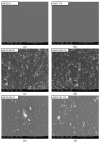The Effect of Carbon-Based Nanofillers on Cryogenic Temperature Mechanical Properties of CFRPs
- PMID: 38475321
- PMCID: PMC10935112
- DOI: 10.3390/polym16050638
The Effect of Carbon-Based Nanofillers on Cryogenic Temperature Mechanical Properties of CFRPs
Abstract
In the present work, the effects of carbon-based nanofillers (0.5 wt%), i.e., graphene nanoplatelets (GNPs), carbon nanofibers (CNFs), and carbon nanotubes (CNTs), on the cryogenic temperature (77 K) mechanical properties of carbon fiber reinforced polymers (CFRPs) were investigated. The study utilized an ex situ conditioning method for cryogenic tests. The nanofillers were mixed with the epoxy matrix by a solvent-free fluidized bed mixing technique (FBM), while unidirectional carbon fibers were impregnated with the resulting nanocomposites to manufacture CFRP samples. Optical microscopy was employed to analyze the dispersion of the carbon-based fillers within the matrix, revealing a homogeneous distribution in nanocomposites containing GNPs and CNFs. Fracture toughness tests confirmed the homogeneity of the GNP-loaded systems, showing an improvement in the stress intensity factor (KC) by 13.2% and 14.7% compared to the unmodified matrix at RT (25 °C) and 77 K, respectively; moreover, flexural tests demonstrated a general increase in flexural strength with the presence of carbon-based nanofillers at both temperature levels (RT and 77 K). Additionally, interlaminar shear strength (ILSS) tests were performed and analyzed using the same ex situ conditioning method.
Keywords: carbon-based nanofillers; cryogenic temperature properties; mechanical properties; nanocomposites.
Conflict of interest statement
Author Valeria Vinti and Luigi Trinchillo were employed by the company Avio S.p.A. The remaining authors declare that the research was conducted in the absence of any commercial or financial relationships that could be construed as a potential conflict of interest.
Figures










References
-
- Soutis C. Carbon fiber reinforced plastics in aircraft construction. Mater. Sci. Eng. A. 2005;412:171–176. doi: 10.1016/j.msea.2005.08.064. - DOI
-
- Friedrich K., Almajid A.A. Manufacturing aspects of advanced polymer composites for automotive applications. Appl. Compos. Mater. 2013;20:107–128. doi: 10.1007/s10443-012-9258-7. - DOI
-
- Garcia-Espinel J.D., Castro-Fresno D., Gayo P.P., Ballester-Muñoz F. Effects of sea water environment on glass fiber reinforced plastic materials used for marine civil engineering constructions. Mater. Des. 2015;66:46–50. doi: 10.1016/j.matdes.2014.10.032. - DOI
-
- Qian D. Fiber-reinforced polymer composite materials with high specific strength and excellent solid particle erosion resistance. Wear. 2010;268:637–642. doi: 10.1016/j.wear.2009.08.038. - DOI
Grants and funding
LinkOut - more resources
Full Text Sources

